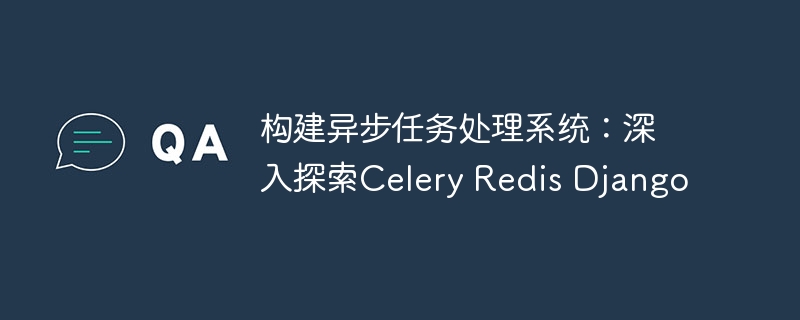

Building an asynchronous task processing system: A deep dive into Celery Redis Django
Introduction:
In modern web application development, asynchronous task processing systems have become An indispensable component. It can greatly improve the performance and scalability of applications, and at the same time, it can separate time-consuming tasks from user requests and improve user experience. This article will deeply explore a powerful asynchronous task processing framework: Celery and two important back-end technologies: Redis and Django, and provide specific code examples.
1. Introduction to Celery
Celery is a distributed task queue framework based on Python. It supports many message middleware, such as RabbitMQ, Redis and Amazon SQS. Its main features include:
2. Introduction to Redis
Redis is an open source in-memory data storage system. It is widely used in scenarios such as caching, message queues, and task queues. Redis supports rich data structures and operations, and has the characteristics of high performance, high availability and persistence.
In Celery, Redis is usually used as the backend of the task queue, which can persist task messages and provide high-speed read and write operations. The following is a sample code for using Redis as the Celery task queue backend:
# settings.py
BROKER_URL = 'redis://localhost:6379/0'
CELERY_RESULT_BACKEND = 'redis://localhost:6379/0'
# celery.py
from celery import Celery
app = Celery('myapp', broker='redis://localhost:6379/0')
@app.task
def add(x, y):
return x + yThis code first configures the URL of Redis in settings.py as the Celery task queue backend and result storage backend. Then in celery.py, a Celery instance is created and a simple task add is defined.
3. Integration of Django and Celery
Using Celery in Django can asynchronousize time-consuming tasks while maintaining the response speed of the interfaces provided by the Django application. The following is a code example for integrating Django with Celery:
# settings.py
CELERY_BROKER_URL = 'redis://localhost:6379/0'
CELERY_RESULT_BACKEND = 'redis://localhost:6379/0'
CELERY_BEAT_SCHEDULE = {
'send-email-every-hour': {
'task': 'myapp.tasks.send_email',
'schedule': crontab(minute=0, hour='*/1'),
},
}
# myapp/tasks.py
from .celery import app
@app.task
def send_email():
# 发送邮件的任务代码First, in settings.py, Celery’s URL is configured as the task queue backend and result storage backend, and the configuration of the scheduled task is defined. Then in myapp/tasks.py, a task named send_email is defined for sending emails.
To use Celery in Django, you also need to create a separate celery.py file to initialize the Celery instance and ensure that it is loaded when the Django application starts. The specific code is as follows:
# celery.py
import os
from celery import Celery
os.environ.setdefault('DJANGO_SETTINGS_MODULE', 'myproject.settings')
app = Celery('myproject')
app.config_from_object('django.conf:settings', namespace='CELERY')
app.autodiscover_tasks()This The code first sets up Django's settings module through the os module, defines the Celery instance used in it, and automatically discovers Django's task module through app.autodiscover_tasks().
Conclusion:
This article briefly introduces Celery, Redis and Django, three important components for building an asynchronous task processing system, and provides specific code examples. By using the combination of Celery, Redis and Django, you can build a high-performance, scalable asynchronous task processing system to improve the performance and user experience of web applications. I hope readers will have a deeper understanding and mastery of building an asynchronous task processing system through the introduction of this article.
The above is the detailed content of Building an Asynchronous Task Processing System: A Deep Dive into Celery Redis Django. For more information, please follow other related articles on the PHP Chinese website!
 Commonly used database software
Commonly used database software
 What are the in-memory databases?
What are the in-memory databases?
 Which one has faster reading speed, mongodb or redis?
Which one has faster reading speed, mongodb or redis?
 How to use redis as a cache server
How to use redis as a cache server
 How redis solves data consistency
How redis solves data consistency
 How do mysql and redis ensure double-write consistency?
How do mysql and redis ensure double-write consistency?
 What data does redis cache generally store?
What data does redis cache generally store?
 What are the 8 data types of redis
What are the 8 data types of redis




